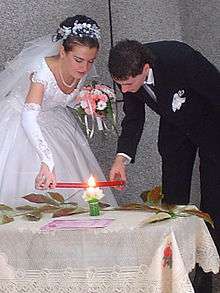Unity candle

A unity candle is a candle used in a wedding ceremony to symbolize two people joining in marriage.
History
The lighting of a "unity candle" is a relatively new inclusion in wedding ceremonies, first appearing sometime in the second half of the 20th century, and most commonly found in American Christian weddings[1]. The origins are unclear, though use of a unity candle in a 1981 episode of General Hospital may have helped to popularize the practice[2].
Symbolism
Use of a unity candle generally symbolizes the joining of two individuals into the marriage bond, but additional allusions may invoked. The flame may be said to represent the passion in each individual's soul for their spouse, or it may compared to the Holy Spirit.
Use
Two taper candles are initially lit and used by each member of the marrying couple. These tapers are then used to light a larger pillar candle in the center. Variations may include additional tapers used by parents to light the tapers that represent the individuals being married.
When the practice is intended to symbolize simply the joining together of the bride and groom, the tapers may be blown out, to indicate that the two lives have been permanently merged, or they may remain lit beside the central candle, symbolizing that the now-married partners have not lost their individuality.[3]
Inclusion in Church Weddings
While the use of unity candles has become widespread, it is prohibited in some churches. It is not part of the Catholic or Anglican wedding ceremonies, and many parishes do not allow its inclusion in the ceremony. While the US Conference of Catholic Bishops has not explicitly prohibited the use of the unity candle in the marriage rite, neither has it encouraged the practice. The Conference has noted that the policies of most dioceses do not prohibit this custom but many suggest that it be done at the reception since the Rite of Marriage already has abundant symbols of unity. The analysis of the Bishops regarding unity candles concludes by indicating that if the unity candle is permitted, the couple should light their individual candles from the paschal candle, the individual candles should not be extinguished and the unity candle should not be placed on the altar.[4]

References
- ↑ https://www.sandiegoreader.com/news/2001/aug/30/what-historyorigin-dreaded-unity-candle/
- ↑ http://catholicphilly.com/2012/09/catholic-spirituality/whats-with-the-unity-candle-in-a-catholic-wedding/
- ↑ Nina Callaway. "Unity Candles and Other Unity Traditions". About.com. Retrieved 2007-12-12.
- ↑ http://www.usccb.org/issues-and-action/marriage-and-family/marriage/marriage-preparation/mpanalysis.cfm